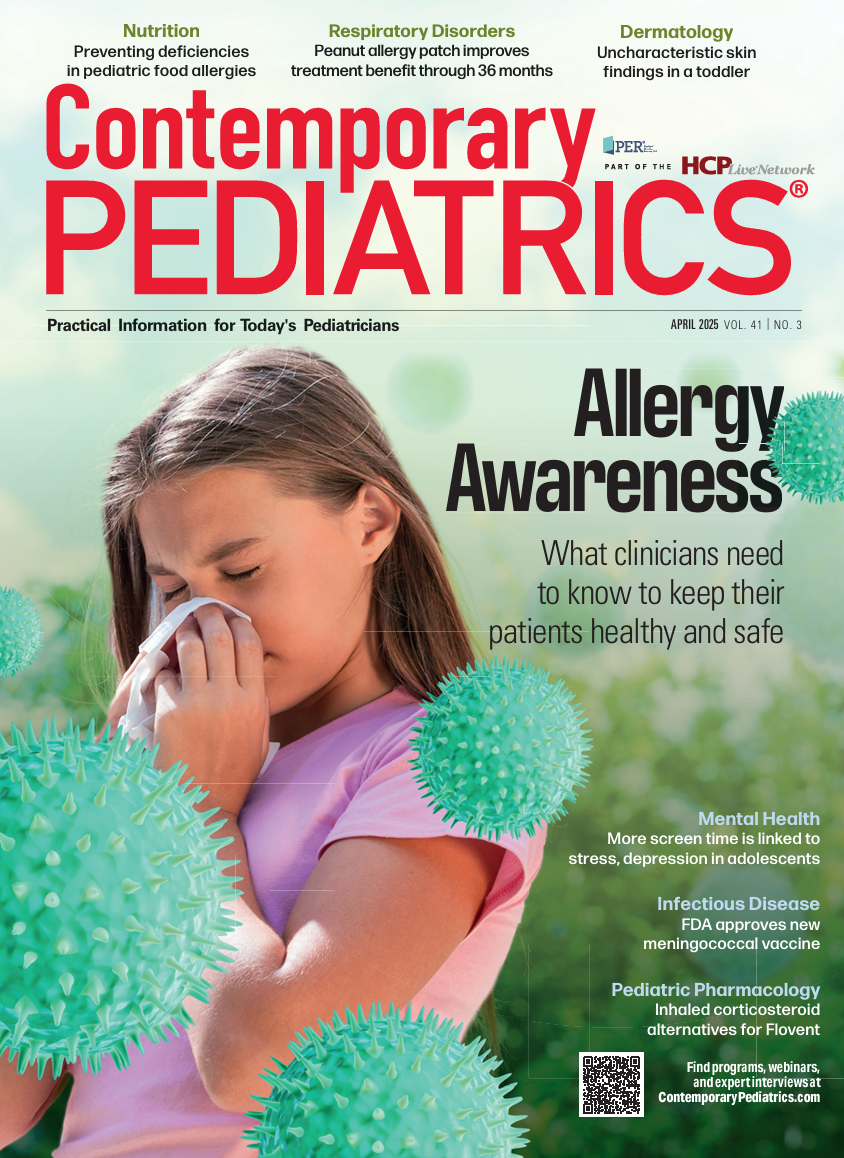Preventing deficiencies in pediatric food allergies
Distinguishing between food allergies and intolerances is crucial.
Preventing deficiencies in pediatric food allergies | Image Credit: © Bungon - © Bungon- stock.adobe.com.

When a child eats a food and has a reaction, parents often panic, assume it’s an allergy, and immediately cut it from their diet. But is it truly an allergy, an intolerance, or something else? The distinction matters. Unnecessary dietary restrictions can create nutrition gaps, leading to deficiencies, impaired growth, and long-term feeding difficulties.
Pediatricians play a crucial role in distinguishing between food allergies and intolerances, preventing unnecessary food avoidance, and guiding families toward balanced nutrition that fills these gaps.
Understanding the difference between food allergy and intolerance
A food intolerance occurs when a child has difficulty digesting certain foods, but the immune system is not involved. Symptoms are dose dependent, meaning small amounts may be tolerated. A food allergy, however, is an immune system reaction to a specific food protein and can be classified as the following:
- IgE-mediated allergies (eg, peanut, egg, milk, tree nuts, wheat, soy, fish, shellfish) cause rapid-onset symptoms such as hives, swelling, vomiting, or anaphylaxis.1 Strict avoidance is required, as even trace amounts can trigger a reaction.
- Non–IgE-mediated allergies (eg, food protein–induced enterocolitis syndrome [FPIES] and cow’s milk protein allergy [CMPA]) cause delayed symptoms, including vomiting, diarrhea, reflux, and growth issues.1 Some tolerance may develop over time, allowing for gradual reintroduction.
- Mixed IgE and non–IgE-mediated allergies (eg, eosinophilic esophagitis) involve both immediate and delayed immune reactions, complicating diagnosis and dietary management.1
Proper testing and diagnosis are essential before eliminating foods. If a patient is allergic, making up for the gap in nutrition is just as important as avoiding a certain food.
Pediatric food allergies and appropriate nutrition interventions
Lactose intolerance vs CMPA
Lactose intolerance and CMPA are often confused, leading to unnecessary dairy elimination. Unlike CMPA, which is an immune response to milk proteins, lactose intolerance results from lactase deficiency and is not an allergy.2 Most children can tolerate moderate amounts of lactose (1-2 cups of milk daily) or low-lactose cheese, such as cheddar, Gouda, or Brie, without symptoms.
CMPA can be IgE or non-IgE mediated and requires the removal of milk proteins.3 In formula-fed infants, extensively hydrolyzed or amino acid–based formulas may be necessary. Soy and goat milk are not suitable replacements due to potential cross-reactivity. Breastfeeding mothers need to eliminate dairy from their own diets while ensuring adequate calcium and vitamin D intake.
Nutrient risks
- Calcium, vitamin D, protein, phosphorus, iodine, vitamin B12, zinc
Substitutions
- Calcium-fortified unsweetened soy or pea protein milk (nutritionally similar to cow’s milk)
- Tofu, canned salmon, sardines, leafy greens (for calcium)
- Legumes, lean meats, eggs, fish (for protein, vitamin B12, and zinc)
- Avocado, eggs, nut butters (for healthy fats)
CMPA resolution: Approximately 80% of children develop tolerance by 3 to 4 years of age.3
FPIES
FPIES is a severe, non–IgE-mediated allergy primarily affecting infants. It causes vomiting, diarrhea, and lethargy hours after consuming trigger foods. The most common triggers include cow’s milk, soy, rice, oats, poultry, fish, eggs, and some vegetables. Unlike IgE allergies, FPIES does not cause anaphylaxis, but reactions can lead to dehydration and failure to thrive.4 Strict avoidance of triggering foods is required, but tolerance often develops over time.
Nutrient risks
- Protein, B vitamins, vitamins A and D, selenium, iodine, folate
Substitutions
- Hydrolyzed or amino acid–based formulas for infants
- Iron-rich foods: lamb, prunes, iron-fortified quinoa/millet, legumes
- Low-risk fruits and vegetables: broccoli, cauliflower, berries, peaches, watermelon
Supplementation: The American Academy of Pediatrics recommends 1 mg/kg of elemental iron daily for predominantly breastfed infants after 4 to 6 months of age.
Reevaluation: Infants with FPIES should undergo an observed oral food challenge 12 to 18 months after the last reaction.
Eosinophilic gastrointestinal diseases
Eosinophilic gastrointestinal (GI) diseases are conditions triggered by both IgE-mediated and T cell–mediated immune responses, leading to eosinophilic infiltration of the GI tract. Eosinophilic esophagitis is the most common form in children.
Symptoms vary by age; infants may struggle with feeding difficulties and reflux, whereas older children often experience dysphagia, coughing after eating, nausea, and food impaction.
Common triggers include dairy, wheat, eggs, soy, nuts, and seafood. Treatment typically involves elimination diets, such as the 6-food or 4-food elimination diet, followed by gradual reintroduction after endoscopic confirmation of disease remission. There are 2 dietary strategies: the step-up and top-down approaches.
The step-up approach, preferred for children, starts by eliminating 1 or 2 common allergens (milk and wheat) and progressively restricts the diet only if remission is not achieved. Though slightly less effective, this method requires fewer unnecessary restrictions and typically only 1 to 4 GI endoscopies.5
Nutrient risks
- Calcium, vitamin D, protein deficiency (due to dairy elimination)
- Iron and B vitamin deficiencies (due to wheat elimination)
- Protein insufficiency (if multiple foods are eliminated)
Substitutions
- For calcium and vitamin D: fortified dairy alternatives, tofu, sardines, leafy greens
- For iron and B vitamins: quinoa, millet, amaranth, lean meat, eggs, fortified gluten-free grains
- For protein insufficiency: legumes, lean meats, eggs, fish
Compassionate nutrition care: Beyond growth monitoring
Food allergies impact more than a child’s physical health—they affect social interactions, emotional well-being, and quality of life. Although growth monitoring is essential, it fails to capture the overwhelming stress and painful isolation that dietary restrictions often create. Partnering with a skilled registered dietitian helps ensure nutritional balance while minimizing unnecessary restrictions. By weaving together clinical expertise with genuine empathy, pediatricians can help families feel truly supported and empowered, ensuring that children with food allergies receive adequate nutrition and can enjoy food and social experiences with confidence.
References:
1. Gargano D, Appanna R, Santonicola A, et al. Food allergy and intolerance: a narrative review on nutritional concerns. Nutrients. 2021;13(5):1638. doi:10.3390/nu13051638
2. Walsh J, Meyer R, Shah N, Quekett J, Fox AT. Differentiating milk allergy (IgE and non-IgE mediated) from lactose intolerance: understanding the underlying mechanisms and presentations. Br J Gen Pract. 2016;66(649):e609-e611. doi:10.3399/bjgp16X686521
3. Coppola S, Carucci L, Oglio F, Di Sarra C, Ozen G, Berni Canani R. Nutritional strategies for the prevention and management of cow’s milk allergy in the pediatric age. Nutrients. 2023;15(15):3328. doi:10.3390/nu15153328
4. Mathew M, Leeds S, Nowak-Węgrzyn A. Recent update in food protein-induced enterocolitis syndrome: pathophysiology, diagnosis, and management. Allergy Asthma Immunol Res. 2022;14(6):587-603. doi:10.4168/aair.2022.14.6.587
5. Votto M, De Filippo M, Lenti MV, et al. Diet therapy in eosinophilic esophagitis. Focus on a personalized approach. Front Pediatr. 2022;9:820192. doi:10.3389/fped.2021.820192
